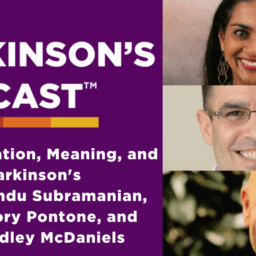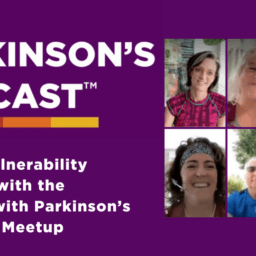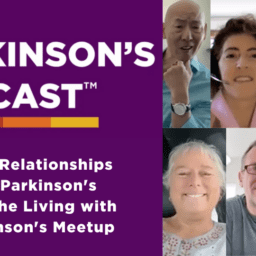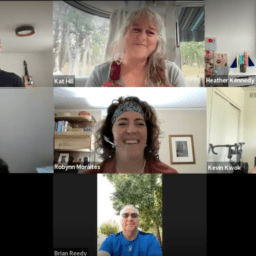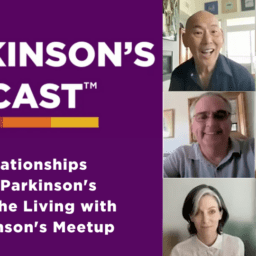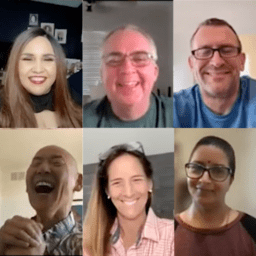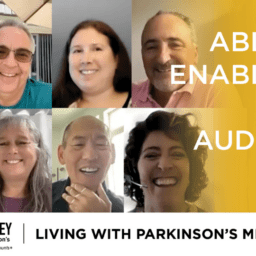Racial differences in Parkinson’s treatment and mortality exist. When it comes to addressing these disparities, the concept of trust comes up in nearly every conversation. But what do we really mean when we talk about trust? In this conversation, Dr. Altaf Saadi and Dr. Consuelo H. Wilkins examine the concept of trust, what we mean when we talk about trust, and how trust is necessary to address health disparities.
A few of the questions our panelists answered included:
- What do we mean when we talk about trust?
- How can trust be built?
- What causes trust to break down?
- How can we measure trust?
- How can communities use existing, trusted relationships to address health disparities?
- How can health care providers and health care institutions be more trustworthy?
You can watch the video below.
To download the audio, click here.
You can read the transcript below. To download the transcript, click here.
Note: This is not a flawless word-for-word transcript but it is close.
Melani Dizon (Director of Education and Research, Davis Phinney Foundation):
That should be working for you right now, if you don’t like seeing the words on the screen. All you have to do is click the little arrow by the CC and say hide subtitles, and you won’t see that we will provide a recording for this webinar, we will have the video recording, the audio recording, as well as the transcript, so we will make sure that you have everything that you need and any links that we talk about during the session today, my colleague Jackie’s in the background, and she will drop the links into the chat. And we will also provide it afterwards in our follow up email. If right now, if you could just click the little icon at the bottom of your screen that says chat, you can let us know that you’re here and that you see us and hear us and all as well in the world. Who’s going to be first? Okay! All good. Hi Frederick. Hello, great, great, thank you so much for joining us today, I’m excited for this conversation.
And I think that’s it. The only last thing I would say is if you’re looking at the screen right now and only see my face. If you look at the top of your dashboard there’s something that says, view, if you if you want to just click that, you can say gallery view and then you’d see everybody here.
Okay, That’s it. David I’m gonna pass it along to you.
David Leventhal (Board of Directors Member, Davis Phinney Foundation and founding teacher and Program Director for Dance for PD®):
Thanks so much, Mel, and again it’s really a great pleasure and an honor to be here and to help moderate, another in our series of conversations around a very critical issue. And this is an issue that we started talking about last year at the Davis Phinney Foundation publicly, we’ve been talking about it a bit for a while before then.
But I’m thrilled to have the honor to listen to and to learn from Dr. Saadi and Dr. Wilkins today. And I’m really here to support them and to moderate this conversation and then in the second half of today, to help bring some of your questions to them, so that they can respond. So just a brief overview of how today’s going to work we’re going to very quickly transition into a conversation between our experts.
I will step back for that point. We’ll give them about half an hour to speak. And then we’ll come back with some of your questions, and we’ll try to address as many of those questions as we can. We will encourage you to forward those questions via chat, and we will try to forward those questions to our experts today. Just a reminder that we will be sending a video and audio recordings of today’s session to you, so if you miss any part of it, or love it so much you want to watch it again or forward it to anyone in your community, who you think might be interested in this topic, we would love for you to do that and we will send you the resources to do that.
Today’s topic is enormously important, it comes up in every conversation that we’ve had about health disparities and the topic today is trust.
So, what do we really mean by trust, what do we mean by trusting your physician, what do we mean by trusting the medical system to make good decisions on our behalf?
In this conversation Dr. Saadi and Dr. Wilkins will examine this current concept of trust, what we mean we talk about trust and how trust is really necessary, it’s one of the first cornerstones that we need to understand to address health disparities to really engage in this conversation.
Our friends at the Foundation have asked two experts to join us. Dr. Consuela Wilkins is the Vice President for Health Equity and a professor of medicine at the Vanderbilt University Medical Center. She’s an expert in this area and we’re honored that she’s with us today.
Dr Saadi also an expert in this area is a general academic neurologist at Massachusetts General Hospital and instructor of Neurology at Harvard Medical School.
She’s also associate director of the MGH Asylum Clinic. Her research is focused on health disparities and social and structural determinants of health among racial and ethnic minorities, immigrants and refugees.
Without further ado, I’m going to welcome you both, and let you take it from here. It is a great pleasure to be able to hear you speak and to learn from you.
So, Dr Saadi and Dr Wilkins, thank you so much for being here.
Dr. Altaf Saadi, MD, MSC (General Academic Neurologist and Associate Director of Asylum Clinic at Massachusetts General Hospital):
Thanks so much, David, I’m so excited to be here, and I have to say I’m so excited to be on this webinar with Dr. Wilkins who’s sort of a superstar and I am junior faculty so it’s just really an honor to participate in this conversation.
Dr. Consuelo H. Wilkins, MD, MSCI (Vice President for Health Equity and a professor of medicine at the Vanderbilt University Medical Center):
I’m honored. I mean, you already shared that your daughter regards you as a queen and I lost that status, a long time ago, so you’re right now more honorable than I am.
Dr. Saadi:
For the context of people who weren’t here for the earlier conversation. My daughter is also two years old.
Well, I think that, you know, one of the things that comes up a lot, and even in the publications I have written about this in, is that you hear trust, you hear mistrust, you hear distrust. I sorta wanted to just, and I’d love to hear from you how you conceptualize that you know, but I think to me they are sort of different things and sometimes people think about them as being on the spectrum, but yeah would love your thoughts. Just starting off the bat and then I can sort of feed off of that but that’s something I hear a lot from people because there’s all this different lingo around that and so just beginning with definitions and differences.
Dr. Wilkins:
Yes, well a great question. I mean, I think, first we should acknowledge that the word trust is very complex. You know, it has many different dimensions and domains and it’s relational as far as you know if you are in a setting of healthcare delivery or relationship, you know a personal relationship that’s not in the healthcare setting. It puts people, or requires, actually, that people often in this vulnerable position.
But I think that trust is, you know, imagining that you have some reliable belief. The reliability, the validity, the competence of something or someone is really how I start to think about trust.
And I do think it’s important to recognize that distrust or mistrust isn’t necessarily on the continuum of trust. On one side there’s trusting, and the other side is distrusting that’s actually not quite correct. You can have high or low trust, more or less trust, and you can also have distrust, which is really you know more of a heightened sense of fear and skepticism that we are seeing a lot right now as we see populations that are marginalized, and minoritized and have been abused or exploited in the past and so there’s this fear that’s sort of built into, you know, I wasn’t treated fairly in the past or people like me were harmed and so part of that distrust actually is a defense mechanism and might be expected, you know it’s a way to protect yourself from not being harmed again.
So again, often times it has less to do with whether or not you as a neurologist is competent, well trained, experienced and all of those things, it’s more about should I believe that people like me, won’t be harmed or that will be treated fairly.
Dr. Saadi:
I was just sort of jotting down two things that I thought really resonated with me one of them was like you sort of said it’s a relational process and so really highlighting to me that in any relationship whether it’s with a child or with a parent or with anyone, there’s the belief component but then there’s also the constant active process component, so it’s not just a belief, but because it’s a relationship we have to think of it as constantly ongoing, and that it really is like this action or process rather than just sort of like an attitude or belief or maybe it’s a combination of both.
That is one of the things you just use saying that I think it’s like really helpful. And then the other thing I think to your point about that it’s a coping mechanism, and I think that’s even with the vaccine, that’s part of the frustration for me of hearing, is that we actually need to normalize this lack of trust that it’s like really normal. It is normal. We want people to be critical. You don’t want people to do things blindly. It’s good for people to ask questions. Those are things we want to encourage and so part of it is also, not thinking that you know, the construct of this is abnormal. It’s like, no, this is a very normal thing, whether it’s coping based on prior experiences, experience personally or from like a community we belong to, but that is a normal coping or reality for people.
Dr. Wilkins:
Yeah, I think it’s incredibly important the aspect you just mentioned about validating people’s, you know, trust, lack of trust or distrust based on their personal beliefs, their experiences, the group experiences. You know, one of the most frustrating things that I’ve seen especially when we’re talking about all the information and misinformation, disinformation related to the vaccine, is that we sort of paint this picture of people being abnormal or, you know, really ridiculing people…
Dr. Saadi:
Yeah, like there’s something wrong with them.
Dr. Wilkins:
Yeah, like why don’t you believe this? Why would you not trust this? As opposed to having the humility to say, I can imagine like this person, these people might not believe or trust or find this information reliable.
Dr. Saadi:
Yeah. And then the other parts, like when you’re saying that it’s sort of not necessarily on a continuum is that those feelings can coexist at the same time, so that you can trust this one physician, at your community health center because you’ve been seeing this one person for many years, and that relationship has been sort of forged and nurtured over the years, but then you go to a new person or you go to a new health center and that those feelings are not mutually exclusive and it can be with one person but not with another person or maybe you can trust physicians, but you don’t trust researchers There’s those differences there.
Dr. Wilkins:
Yeah, that’s one of the most complex things I think for people to try and understand, is that a person can have a high level of distrust at baseline, like you know the skepticism and fear about the healthcare environment, about research, but they can still develop a high level of trust with their provider.
And I’m sure you’ve seen that a lot in your work with, you know, being able to demonstrate to people that you’re providing care for or you’re involving and research that you genuinely care about their well-being, their interest, you’re willing to understand their needs and their priorities. So, they develop this trust with you. That’s not necessarily transferable to everybody at MGH or for me, everybody at Vanderbilt or whatever setting you’re in.
But they’re able to believe enough in you and find you reliable and really trustworthy. So that aspect of, you know, a lot of times too we’re focusing so much on how do we build trust and how do we make people more trusting, as opposed to, you know, how are we more trustworthy, and I think, to really even try and get to this distrust piece, we’re talking about having to change systems and institutions to being more trustworthy. And that’s a huge step. A lot of work would have to be done for that.
Dr. Saadi:
Yeah. I’d love for you to sort of talk through examples of how, maybe these are two separate things, but like health systems building trust and then on the individual level building trust. Maybe we can start with individual levels, I think that’s a little easier, but I was thinking, the example that came to mind was our work with asylum seekers. Sometimes people have been in situations, whether it’s in detention or prison where physicians have watched sort of horrible things happen to them and have condoned horrible things happen to them. And again, this is not just in other countries, like this happens in immigration detention, where physicians are sort of watching horrible things happen and so, when I am having those interactions, I always start with an acknowledgement of negative experiences and to sort of say, look I understand that you know, you might have faced this, and I just want to reassure you like this is where I’m starting, and I’m hear and committed to building this relationship with you. So, that’s one of the, quote on quote strategies that I use, but I think it needs to be part of the picture of acknowledging and validating that that’s normal and it’s fine, I’d love to hear your thoughts of other strategies or tips, in terms of building that trust on an individual level.
Dr. Wilkins:
Well, you already took the best answers. You know, you have to validate people’s feelings, experiences, and let them know in a respectful way that you see them, you hear them, even if you can’t possibly imagine what those experiences were, sometimes you can, sometimes you’ve had those experiences yourself, but sometimes you haven’t it, but being able to actually acknowledge that and really allow people to understand that you accept those things that they say as their truth, and you believe them and you want to learn and you want to hear. And all of those things and so you know if you really think about a part of that is also that you’re trusting them.
So, if you want to be trustworthy, are you trusting them? Are you trusting their lived experiences? They need to be valued in the same way that other people do and that they need to be considered, and the way that they approach their health and well-being, might be different from what we’ve learned or been taught as physicians. So, I think, you know, all of those things are really important and, you know, a piece of that is being empathetic and another piece of that is humility, which is, again, assuming that the person in front of you is as important as you are and everyone else, and I think people need to be able to get that feeling from you.
And I don’t want to go into politics, really, but just imagine you know the amount of mistrust or lack of trust just in general in the political space now and people really trusting individuals or organizations that make them feel validated and seen. That’s a broader concept of, you know, people see them understand them and give some validation or value to their voice.
I think in the setting of the clinical setting as well as the biomedical research setting, effectively communicating with people is really, really critical to being trustworthy and demonstrating that you’re trustworthy. Are you again understanding how a person communicates? What language? Understanding cultural nuances or at least trying to understand those or making space for people to tell you how?
If you get something wrong, and or don’t know how to actually best communicate with people, I think that’s something that’s really practical that I think we could spend more time focusing on.
Dr. Saadi:
When you were talking, I was thinking about like patients and stories, and one of the things that you said, that we don’t talk about enough of is do we trust them?
And started just writing it down because I don’t think we realize how much it’s baked into our education not to trust patients. The person I thought of when you were saying, was I had asked a patient about how much alcohol, they consume in a week. And he said, you know, Doc, I know you guys are taught, if I told you a number, you’re going to just multiply it by three. And so, I’m afraid to even give you a number because I don’t want you to multiply it by three.
And it was just like this moment for me that I was like wow, that yes, I was taught that and maybe it’s changed now, you know I didn’t graduate in the past decade, but that was part of our teaching. It was like, oh the patient is going to tell you this, but you should multiply it, so it’s so baked into our practice, like, do we really trust them? So, I thought that, again, that encounter was something that took me aback. But then even just when you were saying that it was like, well, are we trusting them or when they say something, do we actually believe it or are we just like, well, I’m the one that you should be trusting and not giving people that return.
The other thing which mostly I’d just love your thoughts on, because this is something that I struggle with, is if you have had personal experiences that sort of map along with what someone might be experiencing or seeing, do you talk about that? Do you bring that into the encounter?
Dr. Wilkins:
Um, it depends. I mean, I try to be careful not to de-center, the person in front of me. And sometimes when in attempts to show empathy, or try to validate, we introduce these situations or our personal experiences and the person doesn’t quite see them the same, and actually detract from that. And so, I’m cautious and careful not to do that, but also, I don’t want to take up more time to talk about myself, if possible, especially in the clinical setting, we often have so little time to do that, but when there are those opportunities to let people know how we are alike, I think that’s a good thing. Sometimes that’s more of a casual conversation like we both have kids, you know, we have some shared experience or things that we both like. And I think that’s maybe a safer way so that it doesn’t, sort of detract from other people
So, I’ll give you a quick example. I was having this conversation with some medical students recently, and we were talking and then one of the students, she gave this beautiful presentation about people who are LGBTQIA, sexual gender minorities and sort of affirming specifically how transgender people might feel being referred to by the wrong pronoun, and her example was about how people miss pronounce her name, and how that made her feel, and you know, I think, she was really attempting to make that connection, which on the surface might seem similar, you know, my name is being mispronounced and so I understand how you feel when you’re not being called by the right pronoun, which again is de-centering that experience, which from the standpoint of a transgender person, is likely very different, like no you cannot possibly think that your name being mispronounced is the same as people not accepting the gender that I identify as and how I’m marginalized because of that.
Dr. Saadi:
Yeah. I think that’s a really good example and yeah, I think that can happen. I’ve been in interactions where that has happened to me and you’re in your mind you’re like, no, you don’t know, this is not like your example. So, we’ve talked about sort of the strategies of building trust on an individual level and I had it marked for us to go back and talk about the health system piece, because I think that that’s a really big part of it and one of my sort of fellowship baby projects was, I created a toolkit for creating immigrant friendly health systems and sort of what that means and so, I think about that a lot but yeah, just starting with that, how do you begin to think about that that’s sort of different from the individual level and then thinking about it at the organizational level?
Dr. Wilkins:
I mean I think that if we’re going to address issues like trust at the organizational level, the institutional level, and the health care enterprise system as a level, then we have to start to think about, you know, policy issues. And policy with capital P and a lowercase p, so you know what are the practices and policies that need to change as well, so you know specifically, if we’re thinking about people who have Parkinson’s disease, and who may or may not have had failed treatments in the past, you know their diagnostic tests have been less accurate, they are sort of bouncing around from clinician to clinician and, you know, thinking about how they should have to try and access the system
and might feel marginalized or disenfranchised for different reasons. Then, what kinds of system level changes might actually help build trust among this group of people or their families?
Now, perhaps that’s legislation or policies or even within health systems, changes that would allow for the visits to be extended, so a standard visit for a person with Parkinson’s disease who might have difficulty with ambulation and difficulty with speech, and really the expectation that these people are being you know rushed through an exam or a visit in a short period of time, that that there are you know new codes in the billing system that would really allow for s more appropriate time for people to actually get care and allow for their caregivers to more easily get information about their about their health and management.
So, I think, you know, those kind of broader, what can we do, what kind of oversight programs do we need for a research program that’s focused on a specific disease to make sure that if people who are racial and ethnic minorities, with Parkinson’s Disease are thought of differently have opportunities to participate that their needs are met and those sorts of things, so that that’s sort of standardized in some way.
Dr. Saadi:
I think the point about the length of time at the clinic visits is such a good one because I mean even if you layer, should have limited English proficiency on top of that, and yet we’re expected to see someone in that exact same period of time. So, naturally, that means that that person is getting less time spent with them right because if you’re expected to see them in the same time period but there is that extra time that factors into interpreter use and then if they do have neurologic illness that makes things slower in terms of the encounter, that is like a structural thing that needs to be thought about being shifted to.
Dr. Wilkins:
Let’s imagine also in the setting of telehealth, so you know right now there’s a big push for telehealth and its increased utilization and you know, I’ve been really excited that we’ve been able to push through policies that people thought were just impossible before. We can get them done, but still, you know, the connection for a person with telehealth who needs an interpreter is very complex, you know patching in another person into the visit requires a lot more work and thought, and all the things.
Now let’s imagine that that person has Parkinson’s and has a tremor and might have difficulty using the computer. And, you know, how does that work, what additional accommodations, considerations, practices, policy changes are needed to actually allow people to fully utilize telehealth and you know not to mention that there’s certainly those issues around telehealth that have to do with access, broadband access, the kind of device you have, because, you know, having a telehealth visit with a computer on a table is very different than having it on your phone or you’re in a car.
Dr. Saadi:
Right, like that’s the only quiet place.
I had someone was in their bathroom because they were like, there’s just way too much family and they wanted to discuss something privately and so they were just like in their bathroom for this visit and like this tiny little, it was just, yeah, it’s very different experience.
Dr. Wilkins:
Yeah, or if you’re in a rural community or even an urban environment, and you don’t have Wi Fi at home or in a parking lot using the McDonald’s or Starbucks Wi Fi to do your visit.
Dr. Saadi:
Yeah. Yeah. The other bit when thinking about some of my PD patients, is also that there needs to be the trust, beyond the individual, really with the whole family. And are there multiple people in the family or there might be you know spouse or daughter, and there will be people who have their own sort of sets of beliefs and issues and needing to think about that.
Yeah, I don’t know if you have any thoughts about that or challenges that have come up but I think that comes up a lot, particularly with neurologic diseases because you know we have to a lot of times people rely on their families to be advocates for them.
Dr. Wilkins:
Yeah, I mean, you know, we talk about trust being complex with an individual and organization and then the family, you know, how many children or grandchildren or others are involved in the care side.
And that’s why I’m cautious too. There are some groups that are have higher levels of distress at baseline with fear and skepticism. We know those are groups that are marginalized, minoritized, limited English proficiency, limited resources. Those groups of people tend to have more distrust and less trust. But every individual is different, you can’t, it doesn’t translate across the entire group and within any particular family, you’re going to see varying levels of trust as well as the ability to advocate and understand and navigate the health system. So, you have to certainly add all of those things in, which again this is a very complex setting, being in healthcare.
I would say that certainly for some, groups and cultures, healthcare decisions are more likely to be made as a family. And so, you know, we’re talking about Parkinson’s, more common in older adults, and the family dynamics and cultures involved in decision making also make it more complex as I’m sure you’ve seen it. Yeah.
Dr. Saadi:
I think we’re going to be transitioning to the Q and A soon, but we’ve sort of talked about strategies of nurturing and trust but maybe also being explicit about what causes trust to break down.
So, some of it has sort of already been woven into and out of the conversation but one of the things that you brought up already in terms of like effective communication is really giving as full information.
Which is as basic as like talking through medications side effects, talking through like potential places where things might fail, and being explicit that this could happen so that it doesn’t blindside people, and it’s not like well this person never told me and so then that feeds into ideas that, oh well this person wasn’t sort of giving me the full information, etc.
What are your thoughts? I’m sorry, I keep taking all of the answers and then passing it off to you!
Dr. Wilkins:
Well, I think I’ll speak to medication and treatment. I think that risk and harm, I don’t think in general we do the best job of laying it on the table of what people should expect when we are you know managing, especially conditions as complex and variable as Parkinson’s disease. You know, what exactly should you expect with this specific treatment, what are what are the harms, what are the unintended consequences? And then also, how do people know that we’re there for them? How can they trust us? What are we doing that is demonstrating our trustworthiness?
So, back to that communications piece, you know, do people know what to do when things don’t go as planned, expected? And how do they reach us, and will we be able to communicate effectively with them? And will we validate their experiences? Instead of saying, well, you know, that’s never happened before, or you know, that seems strange. Or you know, I’m not sure. Did you take it right or do it right? So, I think there’s certainly some things that we could be doing, or we should be doing.
Dr. Saadi:
Again, that’s really focusing on our trustworthiness. I think that anticipatory sort of guidance is like bold, italicized, and highlighted, because even just thinking about our patient portal and telling someone to send a message, and when I do that, being explicit that I might not be able to get back to that message like right away, that’s not how that system works and so being able to communicate, this is what to expect through these different routes. So, how to call if you need help, the length of time that it might take, or this is just sort of that participatory guidance. So, whether it’s with just like navigating the healthcare interactions with us or treatments, course of the disease, I think there’s just all these different factors and I think, in the research process, people come, and we sit them through sort of multiple sessions, but it’s not as rigorous and mechanical of a setting often because we’re not required to. We don’t go through that stuff in as much detail.
Dr. Wilkins:
Yeah, well I know we’re transitioning, but I would just say, we didn’t really talk about privacy, but I think especially, you know, thinking about patient portals and how people use them and communicate with each other like that expectation of privacy and, as well as confidentiality.
People are very different and how they view risk of privacy can be very different. And again, these group that have been at risk and marginalized in the past, their perception around privacy can be very different.
Dr. Saadi:
We had that come up with our patients, a lot of our immigrant populations where people would say, oh, is someone going to be listening in on the conversation, is it being recorded, who is it being shared with, are you sharing it? And so, we ended up developing a script that was sort of included by folks who would be signing up people for the patient portal to say, look, here’s how you sign up and then it was part of that introductory script to say like this is confidential, HIPPA, you know, whatever, to sort of give that up front, but I think that that is really key.
And I see David you’ve popped up now and are we transition into the Q and A? Is this the moment?
David Leventhal:
We are, we are gently suddenly transitioning into the moment. We have a lot of great questions and I mean I could listen to the two of you speak for a long time but I want to make sure that we do address some of the questions that come up and so I’m going to circle in if this feels like a good time for the two of you to do that. Yeah, okay.
I want to start actually in the area of provider trust. So, one of the questions that came in which you touched on a little bit is this issue of, I see my movement disorder specialist, every six months for a very short time, the visit feels really rushed. How do I how do I make the most of that visit in terms of trust? And also, part two is, who else can I lean on to kind of help me with that relationship? Or who else in my care team might I trust more, and therefore build a strong relationship with, if I’m only seeing my neurologist, for a short time every six months?
Dr. Wilkins:
So, I’m gonna let you have it.
Dr. Saadi:
Well, I have to say, and this is very true because I practice both at a community health center, and main campus. And at the community health center, we’re so lucky because we have community health workers that I can refer patients to and it is so good that I’ve been pushing our main campus be like we need a community health worker like someone to help people navigate through and we just got funding to do a pilot thing, which is exciting but I think that sort of goes into this piece about one, if you know that that’s something that’s potentially an option asking about it, but for those of us who are enrolled where we can be advocating for patient navigators, community health workers, promotores, like these are positions or roles that can really help and they’ve shown to make a difference in a whole host of neurologic and non-neurologic illnesses.
So, in terms of and I’ll say like what I tell my own patients, and this is challenging because I’m saying this while acknowledging that I saw someone this morning who when I asked about family responded I have no one, but I always start with, like can we loop in other folks in the family that can also help? And trying to sort of myself being proactive and building relationships with the primary care doctor with other doctors who might be part of the team and saying, local part of the team if you can’t get ahold of one of us, you know, touch base with the other person.
But I say that recognizing that there’s a lot of complications in that and that’s why we need sort of structural community organizational responses like community health workers, your peers, you know, patient navigators to sort of fill in those gaps for folks.
Dr. Wilkins:
If I could just add in, you know, just pointing out that that’s a policy issue, especially in places like, you know, Nashville, Tennessee, we don’t have a reimbursement model or…
Dr. Saadi:
Yeah, like who’s paying for it?
Dr. Wilkins:
Who’s paying for it? They’re not committed health workers; we don’t have an association that actually can certify them. And so, you know we found them to be incredibly helpful I mean they are amazing to have, you know, peer educators, navigators, community health workers promotoras. Those individuals are a tremendous asset but we, in many places we don’t have well developed ways of actually reimbursing for their services, training them, and those sorts of things. I also think as far as the you know the interval between visits.
You know, we need a way to easily get sort of objective information into specialists, not to say that your subject of your feelings your symptoms aren’t as important, but, you know, if you when you saw your movement disorder specialist if they said we’ll see you in six months, you know, what’s the trigger to get you in sooner, and how can we make sure that that’s an easy process or way to get that information in so that you
can then get into the, what is most places, a very limited number of movement disorder specialists.
Dr. Saadi:
I think that goes into the anticipatory guidance that was what we’re talking about right like that it needs to be part of the conversation of like this is how to get in touch with me that’s how you get in touch with this other person.
These are the reasons why that you would come to me as opposed to, you know, your primary care doctor.
David Leventhal:
Well, and that dovetails with another question, and that is if you have one movement disorder specialist in your community, it can feel like you don’t have another option even if you don’t fully trust them. So, there’s a question about what you can do to change or advocate for yourself. If this is your situation, which probably requires some of the same skills as building trust in those very short visits. So, you’ve touched on this a little bit but what are some strategies, aside from reaching out to other providers or support systems in the network, what are some strategies that you recommend for kind of self advocacy and kind of standing your ground and speaking up for yourself in those situations where you really don’t have other options.
Dr. Wilkins:
You know, I think that’s a really challenging one, especially when you’re in a setting with limited specialists. So, where else do you go and how else can you get access to, to someone? Is there a support group or organization that can help support and advocate for you or link to other resources? Getting back to telehealth, I think we will see more opportunities for people to link to specialists, sub specialists and other areas remotely now with telehealth. It is certainly something that we are pursuing at Vanderbilt, not specifically for Parkinson’s disease but you know, we’re a regional provider and so certainly, we have many patients who are in bordering states who come to Nashville to get their specialty care and we’ve had to sort of work through some of legal issues around,
you know, if you live in Kentucky, or West Virginia and you usually come to Vanderbilt, then, you know, how can we actually link you to those telehealth visits when you’re in at your home? And that’s more complicated than perhaps some people want to know. But, you know, I think that they’ll be more and more of those opportunities for people to connect to virtual care which is certainly not always ideal but maybe another option.
Dr. Saadi:
Other things I was thinking about when you asked that question David was that, and this is something that I think requires also advocacy within professional organizations, but sort of regional or professional society or conferences can be a really great way to get information and that’s something that I have been like trying to push and I know that for certain organizations like there are parts of them that are being opened up, or they have conferences for people who are you know have a particular disease or disorder and so they’re able to sort of participate in the knowledge and make those connections. And I know, so the American Academy of Neurology and again this is within I think the past five six years that it happened, but you know there’s an annual meeting that happens every year, before physically but now virtually, but what one of the things based on a lot of pushing, both from patients but as well as sort of physician advocacy, was they do like this brain health thing where they actually have physicians that you can rotate through and ask questions and I’ve participated in them.
So, it’s like you can talk and even just, like, get ideas about your particular diagnosis, so I think the professional organizations can be one way in terms of potential for future advocacy and trying to open up more resources for people and I hope as sort of making even continuing knowledge and trials and research more accessible to everyone, but I think that’s another potential venue to push for more access.
David Leventhal: Thank you.
One of our attendees wanted to bring up the issue of censoring symptoms and have spoken to someone recently who said they no longer discuss their depression, because they saw what their doctor had written in the chart. And I guess this gets into something we didn’t talk about a lot is this issue of privacy, and this issue of, you know, feeling comfortable providing your healthcare professional with information they need to support you and to help you but feeling that that information is going to be used wisely and without judgment. So, I know that’s a very complicated question but I’m going to open it up to the two of you to unpack for us a little bit.
Dr. Wilkins:
Yeah, I mean I think the we saw so much of this when we first started making you know the charts, the notes open to patients, obviously you could get your records, you know hard copy of records but you know now, you can just go in and get them and see the notes and people were really taken aback about whether you know how their physicians or clinicians, you know, talked about them and describe them in these in these notes, and I think it really is something that, you know, I as a physician certainly, you know, had to be more conscious of, how we’re taught, often is we really talk about people sometimes as problem lists, and don’t bring in the more human side aspects of it when we’re talking about them that the medical lingo and lots of acronyms, and those things that can be, you know, confusing but certainly David as you pointed out that that judgment piece of how we’re considering information how we’re using it what conclusions we’re coming to based on symptoms that people report is something that we do have to be more cognizant of. But also, I think, in addition to the privacy piece, we have to talk about the respect piece. So, respect is tightly linked to trust. And, you know if people don’t find that you’re respecting them or you’re respecting their values and views are then then they’re certainly not going to trust you.
I do think that considering, how you share information with your providers, being able to say, you know, I answered the questions about depression, you know, what are you going to do with it? What does it mean? And, you know, if you feel like you can have that conversation with the provider to say, you know, I read this and I just want to make sure I understand what this means, and the notes and how it’s being used and what your perceptions are, how that information is being used. which again can be really, really complex.
Dr. Saadi:
I don’t have much to add. I think that if someone feels empowered enough that asking should happen. So, and I’ve had patients who have read my notes and who have said, reverting back and said, look I read this thing and I actually wanted to say this thing you documented was incorrect, and it made me think about this and then I’ve gone back and sort of attended or changed the note.
So, part of our immigrant friendly health systems toolkit is around not documenting immigration status and medical records for example. And so that is a huge piece. I do think that a lot of times, physicians, any clinician, we don’t realize that things that get on medical records stick with people forever and then there’s sort of just gets carried on. And so, I think that we need to do a better job of also including these conversations in our training and sort of understanding the ramifications of what you put in people’s charts.
So, in the context of immigration, for example, like someone, our immigration system is so complex that someone could be undocumented, and then 10 years later could be a citizen and like that’s how it works because people’s immigration status is very complicated, but you put something in someone’s chart, and it sticks, and it doesn’t sort of acknowledge the reality that, you know, something might have changed. I see this also come up a lot around substance use, you know I had one encounter where it just sort of broke my heart with this person has not been using for more than 10 years but it’s like all of his chart and he just literally just felt like he needed to keep apologizing like this was in my past I promise this is my past and I’m just like, Okay, got it, but I think it you know with those things stay in people’s chart so I think that’s one that we really need to do a better job of talking about the ramifications, both from like a stigma perspective and then the piece of like what happens when that information gets in there.
But from the patient and I say like, if you feel empowered enough like take it up, like bring it up to, you know.
Dr. Wilkins:
And sometimes it’s easier to bring it up in a note, in an email to Facebook is just to say, I noticed this in the chart and I’d like to discuss it, or I think you don’t have a full understanding of my symptoms and I’d like to share more about that or your perception is different than mine, and sort of starting it that way, just to bring the attention to the provider so they can be prepared to discuss it and maybe it’s a little bit easier in person if they have that in advance.
David Leventhal:
You both work with medical students in your in your daily life. How much is this issue of trust brought into medical training for the next generation of physicians? And the second part of that is, how do we also train people working in the community outside of the health care model who provide a lot of support for people living with Parkinson’s and other neurological conditions, so training is the question, how do we train in medical school and then how do we transfer some of that information to support group leaders and others who also need to establish relationships based on trust?
Dr. Saadi:
Consuelo I was gonna say I’m gonna let you go first because I feel like you probably deal with it.
Dr. Wilkins:
So, you know I actually think for medical students, we actually probably teach them how to not be trustworthy. You know they come in and they’re so altruistic and they care about everybody and they want to do the right, I think they want to spend a lot of time with the patients and the families and then we sort of put them into these, you know organizations and systems and sort of, you know, teach them how to not communicate, like, use all of this, technical terminology and don’t appear too friendly or connected to people, and so I do think that at least on the medicine side as physicians, we have to stop teaching students how to ignore some of the more human part, like we were so focused on the problem and the diagnosis that we’re less focused on the person as a human being and I think that’s that we actually need to do more work ourselves, and how we do that and how we more effectively communicate with people.
Dr. Saadi:
I think the reason I wanted you to go first was because I was gonna say like there’s so much more that needs to be done so I was like, can we start in a positive way?
But I do think it’s a big gap, I think we need to do more of it, and I think one of the biggest pieces of it is that reflectivity, like what am I bringing to the table? What distrust am I bringing to the table? What assumptions am I bringing to the table that is leading to a decline of sort of trust in this relationship, so I think we need to do better.
Dr. Wilkins:
Yeah. And as far as outside of the health, you know, the health system, and socially, certainly social workers are not outside the health system but you know often people who are working in communities and people who are those bridge builders or, you know, intersecting between the healthcare setting and outside, again, probably are doing a lot of those things better than we’re doing in medicine, they’re communicating, and they’re spending more time, they’re making sure they understand an individual’s circumstances and needs.
And, you know, not all of that is just due to time and so again I think we as healthcare providers, especially as researchers too, we don’t listen to the story, we’re not hearing what people are telling us.
David Leventhal:
Yeah. I’m also thinking about programs that have really innovated the possibilities inherent in giving people who are already trusted sources of information, in specific communities, the tools to help others navigate health concerns.
So, providing for example health information in hair salons or in places of worship, so that people who already have, you know, have established that trust, and are turned to for information, can have the information public health information then to give out, so there are many, many partners at play in building trust and making sure that people get the care that they need and deserve.
So, with that, we’re going to wrap up this really fascinating, informative hour. I want to thank you both for your time for your insight, your perspectives.
I know we’re at the beginning of this journey, many institutions are the beginning of this journey, but even the field of health care in general is really starting to ask the hard questions and we all have work to do in figuring out how better to support and nurture our community. So, I’d like to thank you both for your time and for your expertise. I’d like to thank the Davis Phinney Foundation and Dance for PD program for partnering to host the series, I really want to encourage people to reach out to the Davis Phinney Foundation with additional questions or requests for the series. This series has developed through your input and so if there are specific topics that you want to hear about and want to know more about, please let us know. As well, speaking of trust if there are things that you really wanted to ask but didn’t feel like this was a safe space for you to do that, you are welcome to send that to Jenna, and Jenna will put her email in the in the chat now so that you have that information.
I also want to announce that our next webinar in this series will take place May 27th. Our guests will be Dr. Nicte Mejia and Aswita Tan-McGrory.
Stay tuned for more information about that on the Foundation website. I also want to remind you that a transcript for this presentation as well as the video and audio recordings will be distributed to you for reviewing or sharing.
And I want to thank all of you today for joining us for this truly important discussion and for asking, wonderful questions that have simulated great conversation and thought.
Show Notes
- Trust is a complex term because it can exist in a variety of circumstances. Dr. Consuelo defines trust as a reliable belief or, more specifically, a reliability, validity, or the competence of something or someone
- For people who are marginalized, minoritized, and/or have been abused or exploited in the past, distrust of medical care may be a natural defense mechanism based on past experiences, not based on credentials or experience
- Try not to judge people for their mistrust, but rather, have the humility to think, “I can imagine why this person might not trust this information or find it reliable”
- Within the medical profession in particular, trust can be built on an individual level as well as on an organizational level
- To build trust on an individual level, it is important to validate a person’s feelings and experiences as their truth; to believe that they are as important as you are; to understand and exhibit effective communication among different kinds of people; and to show empathy without invalidating the person in the process by relating the experience to yourself
- To build more trust on an organizational level, new policies need to be enacted. Some examples of policy change that may increase patient trust might be increasing appointment lengths, creating new billing codes to support longer appointment times, and including topics such as effective communication across cultures into the educational curriculum for medical professionals
- It is important to understand that a person who has a general mistrust of medical care may develop trust with an individual professional. This, however, does not automatically transfer to all medical professionals
- For communities that are mistrusting of medical care in general, an effective way to get them proper medical information and care may be to give the appropriate materials to a trusted individual within the community, who can then distribute the information
additional resources
How to Communicate More Effectively With Your Doctor
Toolkit for Providers Serving Immigrant Communities
Health Disparities and Parkinson’s: Understanding the Issue
Health Disparities and Parkinson’s: Bridging the Gap Between Urban and Rural
meet the panelists
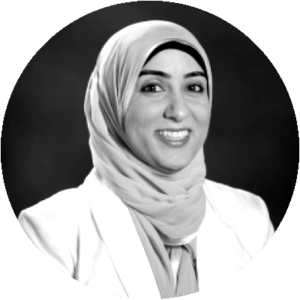
General Academic Neurologist and Associate Director of Asylum Clinic at Massachusetts General (MGH) and instructor of neurology at Harvard Medical School. She is also associate director of the MGH Asylum Clinic.
d
d
d
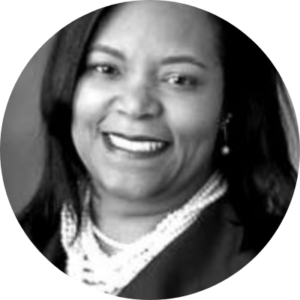 Vice President for Health Equity, VUMC
Vice President for Health Equity, VUMC
Associate Dean for Health Equity, Vanderbilt SOM
Engagement Core Director, All of Us Research Program
Associate Director, Vanderbilt Institute for Clinical and Translational Science
Professor of Medicine, Division of Geriatric Medicine
Geriatric Medicine Fellowship Program Faculty
f
Moderator
 Program Director, Dance for PD®, Mark Morris Dance Group, and Board of Directors, Davis Phinney Foundation
Program Director, Dance for PD®, Mark Morris Dance Group, and Board of Directors, Davis Phinney Foundation
d
Learn More about Health Disparities and Parkinson’s
We created our Health Disparities and Parkinson’s Webinar Series as part of our commitment to understanding and working to change deeply rooted inequities in healthcare that black, brown, and indigenous communities; LGBTQ+; immigrant, and refugee communities; and people of color experience. Learn more and register for the next webinar in the series here.
Presented in partnership with:








